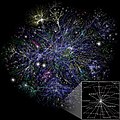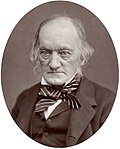The Bianconi–Barabási model is named after its inventors Ginestra Bianconi and Albert-László Barabási. This model is a variant of the Barabási–Albert...
22 KB (3,121 words) - 19:54, 12 October 2024
its degree. The BA model claims that this explains the preferential attachment probability rule. Later, the Bianconi–Barabási model works to address this...
21 KB (2,744 words) - 03:34, 4 June 2025
multilayer and higher-order networks, and in particular for the Bianconi–Barabási model of growing of complex networks and for the Bose–Einstein condensation...
6 KB (500 words) - 06:42, 30 May 2025
Scale-free network (redirect from Generalized scale-free model)
Graph of connected web pages Barabási–Albert model – Scale-free network generation algorithm Bianconi–Barabási model – model in network sciencePages displaying...
47 KB (6,013 words) - 05:15, 12 April 2025
Ginestra Bianconi and Albert-László Barabási proposed a new model called Bianconi-Barabási model, a variant to the Barabási-Albert model (BA model), where...
6 KB (863 words) - 15:34, 13 November 2023
preferential attachment family of models, such as the Barabási–Albert (BA) model. (On the other hand, the Barabási–Albert model fails to produce the high levels...
11 KB (1,613 words) - 14:01, 15 May 2025
Harvard University. In 1999 Barabási discovered the concept of scale-free networks and proposed the Barabási–Albert model, which explains the widespread...
40 KB (4,111 words) - 13:58, 29 March 2025
Node deletion (section Barabási-Albert model)
so the diameter goes up. Barabási, A.-L. NETWORK SCIENCE, Cambridge University Press 2015 Albert, R.; Jeong, H.; Barabási, A.L. Error and attack tolerance...
5 KB (766 words) - 12:14, 6 November 2023
hypercubes. Some models of growing networks that produce scale-invariant degree distributions are the Barabási–Albert model and the fitness model. In a network...
19 KB (2,448 words) - 15:52, 5 January 2025
in effect, makes the Watts–Strogatz model a random network. The Barabási–Albert model is a random network model used to demonstrate a preferential attachment...
69 KB (9,906 words) - 21:46, 25 May 2025
social networks. Some modeling alternatives include Barabási–Albert model and Watts and Strogatz model. These alternative models are not percolation processes...
19 KB (2,795 words) - 05:56, 9 April 2025
Boolean network (redirect from RBN model)
synchronously or asynchronously. Boolean networks have been used in biology to model regulatory networks. Although Boolean networks are a crude simplification...
25 KB (2,831 words) - 22:14, 7 May 2025
Global cascades models are a class of models aiming to model large and rare cascades that are triggered by exogenous perturbations which are relatively...
8 KB (1,087 words) - 11:05, 10 February 2025
hierarchical models nodes with more links are expected to have a lower clustering coefficient. Moreover, while the Barabási-Albert model predicts a decreasing...
9 KB (1,192 words) - 03:30, 26 March 2024
Topology Random graph Erdős–Rényi Barabási–Albert Bianconi–Barabási Fitness model Watts–Strogatz Exponential random (ERGM) Random geometric (RGG) Hyperbolic...
7 KB (1,376 words) - 19:24, 17 May 2025
Exponential family random graph models (ERGMs) are a set of statistical models used to study the structure and patterns within networks, such as those...
24 KB (3,620 words) - 07:14, 16 March 2025
Random geometric graph (redirect from Gilbert disk model)
algorithms, such as those generated using the Erdős–Rényi model or Barabási–Albert (BA) model do not create this type of structure. Additionally, random...
17 KB (2,603 words) - 20:37, 24 March 2025
Similarly the Price model for scientific citations corresponds to the case k0 = 0, a = 1 and the widely studied Barabási-Albert model corresponds to k0 = m...
14 KB (1,778 words) - 23:06, 20 May 2025
Random graph (section Models)
refers almost exclusively to the Erdős–Rényi random graph model. In other contexts, any graph model may be referred to as a random graph. A random graph is...
15 KB (2,328 words) - 11:46, 21 March 2025
networks have been modelled by DCM, such as neural networks, finance and social networks. Network Science by Albert-László Barabási. Bollobás, B. (1980)...
30 KB (4,487 words) - 07:39, 25 May 2025
Potts Model (RB). This model is used by default in most mainstream Leiden algorithm libraries under the name RBConfigurationVertexPartition. This model introduces...
21 KB (3,127 words) - 18:06, 2 June 2025
computer scientists, and physicists such as Duncan J. Watts, Albert-László Barabási, Peter Bearman, Nicholas A. Christakis, James H. Fowler, Mark Newman, Matthew...
58 KB (6,267 words) - 17:59, 10 April 2025
multilayer and higher-order networks, and in particular for the Bianconi–Barabási model of growing of complex networks and for the Bose–Einstein condensation...
30 KB (2,874 words) - 15:12, 22 March 2025
In the early 1970s, Leonard Kleinrock carried out mathematical work to model the performance of packet-switched networks, which underpinned the development...
97 KB (11,568 words) - 15:13, 30 May 2025
The stochastic block model is a generative model for random graphs. This model tends to produce graphs containing communities, subsets of nodes characterized...
17 KB (2,073 words) - 01:48, 27 December 2024
as models to understand seizures. Barabási–Albert model – Scale-free network generation algorithm Climate as complex networks – Conceptual model to generate...
38 KB (4,646 words) - 01:15, 11 April 2025
community structure. Many basic network models, for example, such as the random graph and the Barabási–Albert model, do not display community structure....
37 KB (4,591 words) - 20:57, 1 November 2024
widely known generative models for scale-free networks are stochastic, such as the Barabási–Albert model or the Fitness model can reproduce many properties...
5 KB (819 words) - 22:43, 17 March 2025
original on 2013-12-18. Retrieved 2013-12-08. "NetworkScience". Albert-László Barabási. Archived from the original on 2020-03-05. Retrieved 2020-03-20. Clauset...
21 KB (2,962 words) - 15:52, 21 February 2025
Network topology (redirect from Networking Models)
theory wherein communicating devices are modeled as nodes and the connections between the devices are modeled as links or lines between the nodes. Physical...
40 KB (5,238 words) - 09:07, 24 March 2025










